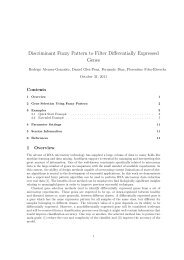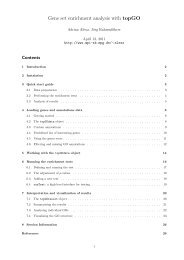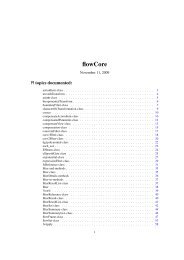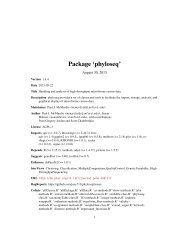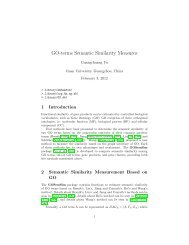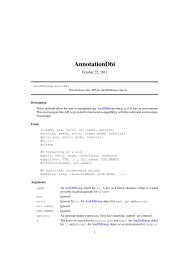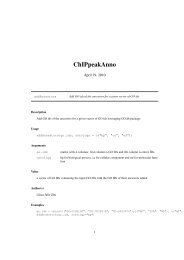Package 'Heatplus'
Package 'Heatplus'
Package 'Heatplus'
- No tags were found...
Create successful ePaper yourself
Turn your PDF publications into a flip-book with our unique Google optimized e-Paper software.
plot.annHeatmap 21<br />
plot.annHeatmap<br />
Plotting method for annotated heatmaps<br />
Description<br />
Usage<br />
Plotting method for annotated heatmaps<br />
## S3 method for class ’annHeatmap’<br />
plot(x, widths, heights, ...)<br />
Arguments<br />
x<br />
Details<br />
Value<br />
widths<br />
heights<br />
an object of class annHeatmap<br />
a numerical vector giving the widths of the sub-plots currently defined<br />
a numerical vector giving the heights of the sub-plots currently defined<br />
... extra graphical parameters, currently ignored<br />
This function displays an annotated heatmap object that has been previously generated by annHeatmap2<br />
or on of its wrappers. The arguments widths and heights work as in layout.<br />
x, invisibly returned. If widths or heights have been specified, they overwrite the corresponding<br />
items x$layout$width and x$layout$height in x.<br />
See Also<br />
annHeatmap2, heatmapLayout, layout<br />
Examples<br />
## Define the map<br />
require(Biobase)<br />
data(sample.ExpressionSet)<br />
ex1 = sample.ExpressionSet[51:85,]<br />
map1 = annHeatmap2(exprs(ex1), ann=list(Col=list(data=pData(ex1))),<br />
cluster=list(Col=list(cuth=3000)))<br />
## Plot it<br />
plot(map1)<br />
## More heatmap, smaller dendrogram/annotation<br />
map2 = plot(map1, heights = c(1,6,1))



